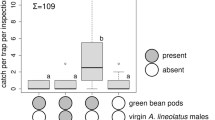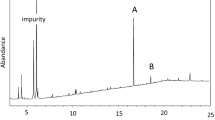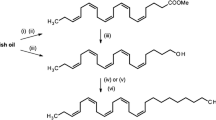Abstract
The sex pheromone blend of a European strain of the black cutworm moth, Agrotis ipsilon (Hufnagel), was investigated. Chemical analyses of pheromone gland extracts from 4- to 8-day-old females showed that individual isolated glands contained only very small amounts of pheromone. High-resolution gas chromatography combined with mass spectrometry (GC–MS) analyses showed the presence of cis-7-dodecenyl acetate (Z7-12:Ac), cis-9-tetradecenyl acetate (Z9-14:Ac), cis-11-tetradecenyl acetate (Z11-14:Ac), cis-11-hexadecenyl acetate (Z11-16:Ac), and cis-11-hexadecenol (Z11-16:OH) in biologically active pheromone gland extracts. Removing 27-12: Ac, Z9-14:Ac, or Z11-16:Ac from the complete gland extract by GC trapping techniques strongly reduced the attractiveness of the pheromone blend tested in a wind tunnel. Lack of cis-5-decenyl acetate (Z5-10:Ac) or Z11-16:OH did not affect the blend attractiveness. Chemical and behavioral analyses showed that pheromone components are produced during photophase, at least 2 hr before lights off. Quantitative data showed that decapitation inhibited the production of Z7-12:Ac, Z9-14:Ac, Z11-14:Ac, Z11-16:Ac, and Z11-16:OH, but production in decapitated females was stimulated in response to injection of synthetic Heliothis zea PBAN (pheromone biosynthesis activating neuropeptide) or A. ipsilon brain–subesophageal (Br-SEG) homogenates. Moreover, upon injecting BR-SEG homogenates, other minor components were detected, which were tentatively identified as cis-8-dodecenyl actetate (Z8-12:Ac) and Z5-10:Ac. Our study demonstrated that Z11-l6:Ac is one of the main active components produced by the pheromone gland of this European population of A. ipsilon, in addition to Z7-12:Ac/Z9-14:Ac, which were investigated in a previous behavioral analysis. All these data strongly suggest that some polymorphism is present in pheromone communication in different strains of A. ipsilon.
Similar content being viewed by others
REFERENCES
ARN, H., ESBJERG, P., BUÈS, R., TOTH, M., SZOCS, G., GUERIN, P., and RAUSCHER, S. 1983. Field attraction of Agrotis segetum males in four European countries to mixtures containing three homologous acetates. J. Chem. Ecol. 9:267–276.
ARN, H., TOTH, M., and PRIESNER, E. 1992. List of Sex Pheromones of Lepidoptera and Related Attractants, in OILB, 2nd ed.
BABILIS, N. A., and MAZOMENOS, B. E. 1992. Pheromone production in Sesamia nonagrioides: Diel periodicity and effect of age and mating. J. Insect Physiol. 38:561–564.
BJOSTAD, L. B., WOLF, W. A., and ROELOFS, W. L. 1981. Total lipid analysis of the sex pheromone gland of the red-banded leafroller moth, Argyrotaenia velutinana, with reference to pheromone biosynthesis. Insect Biochem. 11:73–79.
CAUSSE, R., BUÈS, R., BARTHES, J., and TOUBON, J. F. 1988. Mise en evidence expérimentale de nouveaux constituants des phéromones sexuelles de Scotia ipsilon Hüfn. et Mamestra suasa Schiff (Lépidoptères, Noctuidae) pp. 75–82, in Médiateurs Chimiques: Comportement et Systématique des Lépidoptères. Application en Agronomie. INRA, Paris.
CAUSSE, R., BUÈS, R., BARTHÈS, J., TOUBON, J. F., and POITOUT, S. 1989. Utilisation du piégeage sexuel pour l'étude des migrations d'Agrotis ipsilon Hüfnagel (Lepidoptera, Noctuidae). Comparaison avec le piégeage lumineux. Bull. OILB/SROP 12:49–50.
COMMON, I. F. B. 1958. The Australian cutworms of the genus Agrotis (Lepidoptera: Noctuidae). Aust. J. Zool. 6:69–88.
DELISLE, J., and ROYER, L. 1994. Changes in pheromone titer of oblique-banded, Choristoneura rosaceana, virgin females as a function of time of day, age, and temperature. J. Chem. Ecol. 20:45–69.
DOOLITTLE, R. E., and SOLOMON, J. D. 1986. Stereoselective synthesis of (Z,E)-3,5-tetradecadieny acetate: Sex attractant for carpenterworm moth, Prionoxystus robiniae (Peck) (Lepidoptera: Cossidae), and effect of isomers and monounsaturated acetates on its attractiveness. J. Chem. Ecol. 12:619–633.
DUNKELBLUM, E., and MAZOR, M. 1993. Chemical characterization and species specificity of sex pheromones of Plusiinae moths in Israel. Arch. Insect Biochem. Physiol. 22:413–424.
FRÉROT, B., MARRO, J. P., and MALOSSE, C. 1995. In vitro incubation of sex pheromone gland and identification of pheromone components in Cydia splendana (Hb). C. R. Acad. Sci. Paris 318:447–451.
GADENNE, C. 1993. Effects of fenoxycarb, juvenile hormone mimetic, on female sexual behaviour of the black cutworm, Agrotis ipsilon (Lepidoptera: Noctuidae). J. Insect Physiol. 39:25–29.
GADENNE, C., RENOU, M., and SRENG, L. 1993. Hormonal control of pheromone responsiveness in the male black cutworm, Agrotis ipsilon. Experientia 49:721–724.
GANESWARA RAO, A., KRISHNAIAH, K., HALL, D. R., CORK, A., and REDDY, D. D. R. 1993. Evaluation of sex pheromone components of rice leaf folder, Cnaphalocrocis medinalis, Guenee. Curr. Sci. 65:355.
GIEBULTOWICZ, J. M., WEBB, R. E., RAINA, A. K., and RIDGWAY, R. L. 1992. Effects of temperature and age on daily changes in pheromone titer in laboratory reared and wild gypsy moth, Lymantria dispar (L.) (Lepidoptera, Lymantriidae). Environ. Entomol. 21:821–826.
HAYNES, K. S., GASTON, L. K., POPE, M. M., and BAKER, T. C. 1983. Rate and periodicity of pheromone release from individual female artichoke plume moth, Platyptilia carduidactyla (Lepidoptera: Pterophoridae). Environ. Entomol. 12:1597–1600.
HILL, A. S., RINGS, R. W., SWIER, S. R., and ROELOFS, W. L. 1979. Sex pheromone of the black cutworm moth, Agrotis ipsilon. J. Chem. Ecol. 5:439–457.
KINGAN, T. G., BLACKBURN, M. B., and RAINA, A. K. 1992. The distribution of pheromone-biosynthesis-activating-neuropeptide (PBAN) immunoreactivity in the central nervous system of the corn earworm moth, Helicoverpa zea. Cell Tissue Res. 270:229–240.
KITAMURA, A., NAGASAWA, H., KATAOKA, H., INOUE, T., MATSUMOTO, S., ANDO, T., and SUZUKI, A. 1989. Amino acid sequence of pheromone biosynthesis activating neuropeptide (PBAN) of the silkworm, Bombyx mori. Biochem. Biophys. Res. Commun. 163:520–526.
KITAMURA, A., NAGASAWA, H., KATAOKA, H., ANDO, T., and SUZUKI, A. 1990. Amino acid sequence of pheromone biosynthesis activating neuropeptide-II (PBAN-II) of the silkworm, Bombyx mori. Agr. Biol. Chem. 54:2495–2497.
KLUN, J. A., and MAINI, S. 1979. Genetic basis of an insect chemical communication system: The European corn borer. Environ. Entomol. 8:423–426.
KLUN, J. A., CHAPMAN, O. L., MATTES, K. C., WOJTKOWSKI, P. W., BEROZA, M., and SONNET, P. E. 1973. Insect sex pheromones: Minor amount of opposite geometrical isomer critical to attraction. Science 181:661–663.
LIU, Y. B., and HAYNES, K. F. 1993. Impact of (Z)-7-dodecenol and turbulence on pheromone-mediated flight manoeuvres of male Trichoplusia ni. Physiol. Entomol. 18:363–371.
LÖFSTEDT, C., VAN DER PERS, J. N. C., LÖFQVIST, J., LANNE, B. S., APPERLGREN, M., BERSTRÖM, G., and THELIN, B. 1982. Sex pheromone components of the turnip moth, Agrotis segetum, chemical identification, electrophysiological evaluation and behavioral activity. J. Chem. Ecol. 8:1305–1321.
LOFSTEDT, C., LÖFQVIST, J., LANNE, B. S., VAN DER PERS, J. N. C., and HANSSON, B. S. 1986. Pheromone dialects in European turnip moths, Agrotis segetum. Oikos 46:1305–1321.
MASLER, E. P., and RAINA, A. K. 1993. Pheromonotropic activity in the gypsy moth Lymantria dispar: Evidence for a neuropeptide. J. Comp. Physiol. B 163:259–264.
MAZOR, M., and DUNKELBLUM, E. 1992. Role of sex pheromone components in behavioral reproductive isolation between Autographa gamma (L.) and either Trichoplusia ni (Hübner) or Chrysodeixis chalcites (Esp.) (Lepidoptera: Noctuidae: Plusiinae). J. Chem. Ecol. 18:2373–2384.
MAZOR, M., HAREL, M., LEVSKY, S., and DUNKELBLUM, E. 1991. Sex pheromone components of female Cornutiplusia circumflexa. Entomol. Exp. Appl. 60:167–172.
MILLAR, J. G., and RICE, R. E. 1996. 5-Decyn-1-y1 acetate: Powerful antagonist of peach twig borer (Lepidoptera: Gelechiidae) sex pheromone. J. Econ. Entomol. 89:131–133.
ONYANGO ODIYO, P. 1975. Seasonal distribution and migrations of Agrotis ipsilon Hüfn. (Lep. Noctuidae). Center for Overseas Pest Research, Tropical Pest Bull. 4:26.
PICIMBON, J. F. 1995. Sex Pheromones of Moths: Determination, Regulation and Perception, MS thesis. University of Aix-Marseille III, Marseille, France.
PICIMBON, J. F., BECARD, J. M., SRENG, L., CLÉMENT, J. L., and GADENNE, C. 1995. Juvenile hormone stimulates pheromonotropic brain factor release in the female black cutworm. Agrotis ipsilon. J. Insect Physiol. 41:377–382.
POITOUT, H. S., and BUÈS, R. 1974. Élevage de plusieurs espèces de lépidoptères sur milieu artificiel simplifié. Ann. Zool. Ecol. Anim. 2:79–91.
POPE, M. M., GASTON, L. K., and BAKER, T. C. 1984. Composition, quantification and periodicity of sex pheromone volatiles from individual Heliothis zea females. J. Insect Physiol. 12:943–945.
PRIESNER, E., and WITZGALL, P. 1984. Modification of pheromonal behaviour in wild Coleophora laricella male moths by (Z)-5-decenyl acetate, an attraction-inhibitor. Z. Angew. Entomol. 98:118–135.
QUARTEY, G. K., and COAKER, T. H. 1993. Role of sex pheromone components in the orientation behaviour of Ephestia cautella. Entomol. Exp. Appl. 66:237–245.
RAFAELI, A., SOROKER, V., HIRSCH, J., KAMENSKY, B., and RAINA, A. K. 1993. Influence of photoperiod and age on the competence of pheromone glands and on the distribution of immunoreactive PBAN in Helicoverpa spp. Arch. Insect Biochem. Physiol. 22:169–180.
RAINA, A. K. 1993. Neuroendocrine control of sex pheromone biosynthesis in Lepidoptera. Annu. Rev. Entomol. 38:329–349.
RAINA, A. K., KLUN, J. A., and STADELBACHER, E. A. 1986. Diel periodicity and effect of age and mating on female sex pheromone titer in Heliothis zea (Lepidoptera: Noctuidae). Ann. Entomol. Soc. Am. 79:128–131.
RAINA, A. K., JAFFE, H., KLUN, J. A., RIDGWAY, R. L., and HAYES, D. K. 1987. Characteristics of a neurohormone that controls sex pheromone production in Heliothis zea. J. Insect Physiol. 33:809–814.
RAINA, A. K., JAFFE, H., KEMPE, T. G., KEIM, P., BLACHER, R. W., FALES, H. M., RILEY, C. T., KLUN, J. A., RIDGWAY, R. L., and HAYES, D. K. 1989. Identification of a neuropeptide hormone that regulates sex pheromone production in female moths. Science 244:296–298.
RASMUSSEN, L. E. L., LEE, T. D. ROELOFS, W. L., ZHANG, A., and DOYLE DAVIES, G., JR. 1996. Insect pheromone in elephants. Nature 379:1.
RENOU, M., GADENNE, C., and TAUBAN, D. 1996. Electrophysiological investigations of pheromone sensitive sensilla between two moths species. J. Insect Physiol. 42:267–277.
RINGS, R. W., ARNOLD, F. J., and JOHNSON, B. A. 1975. Host range of the black cutworm on vegetables. Bull. Entomol. Soc. Am. 21:229–234.
ROELOFS, W. L., GLOVER, T., TANG, X. H., SRENG, I., ROBBINS, P., ECKENRODE, C., LÖFSTEDT, C., HANSSON, B. S., and BENGTSSON, B. O. 1987. Sex pheromone production and perception in European corn borer moths is determined by both autosomal and sex-linked genes. Proc. Natl. Acad. Sci. USA 84:7585–7589.
SHOWERS, W. B., SMELSER, R. B., KEASTER, A. J., WHITFORD, F., ROBINSON, J. F., LOPEZ, J. D., and TAYLOR, S. E. 1989a. Recapture of marked black cutworm (Lepidoptera: Noctuidae) males after long-range transport. Environ. Entomol. 18:447–458.
SHOWERS, W. B., WHITFORD, F., SMELSER, R. B., KEASTER, A. J., ROBINSON, J. F., LOPEZ, J. D., and TAYLOR, S. E. 1989b. Direct evidence for meteorologically driven long-range dispersals of an economically important moth. Ecology 70:987–992.
SHOWERS, W. B., KEASTER, A. R., RAULSTON, J. R., HENDRIX, W. H., III, ELLISON DERRICK, M., MC CORLE, M. D., ROBINSON, J. F., WAY, M. O., WALLENDORF, M. J., and GOODENOUGH, J. L. 1993. Mechanism of southward migration of a noctuid moth, Agrotis ipsilon (Hufnagel): A complete migrant. Ecology 74:2303–2314.
SOWER, L. L., SHOREY, H. H., and GASTON, L. K. 1972. Sex pheromones of Lepidoptera. XXVIII. Factors modifying the release rate and extractable quantity of pheromone from females of Trichoplusia ni (Noctuidae). Ann. Entomol. Soc. Am. 65:954–957.
SRENG, L., MOREAU, R., and GIRARDIE, A. 1990. Locust neuropeptides stimulating sex pheromone production in female European corn borer moth, Ostrinia nubilalis. J. Insect Physiol. 36:719–726.
STRUBLE, D. K., ARN, H., BUSER, H. R., STADLER, E., and FREULER, J. 1980. Identification of 4 sex pheromone components isolated from calling females of Mamestra brassicae. Z. Naturforsch. 35c:45–48.
SUBCHEV, M. A., STANIMIROVA, L. S., and STOILOV, I. L. 1985. Effect of cis-11-hexadecenol and its derivatives on the pheromonal activity of cis-11-hexadecenyl acetate to males of three noctuid species (Lepidoptera: Noctuidae) in field. Ecology 16:70–74.
SUBCHEV, M. A., STANIMIROVA, L. S., and MILKOVA, T. S. 1987. The effect of compounds related to cis-11-hexadecenyl acetate on its attractiveness to the males of Mamestra brassicae L. (Lepidoptera: Noctuidae) and some other noctuid species. Folia Biol. 35:143–150.
SWIER, S. R., RINGS, R. W., and MUSICK, G. J. 1977. Age related calling behaviour of the black cutworm, Agrotis ipsilon. Ann. Entomol. Soc. Am. 70:919–924.
TANG, J. D., CHARLTON, R. E., CARDE, R. T., and YIN, C. M. 1992. Diel periodicity and influence of age and mating on sex pheromone titer in gypsy moth, Lymantria dispar (L.). J. Chem. Ecol. 18:749–760.
TEAL, P. E. A., HEATH, R. R., TUMLINSON, J. H., and MC LAUGHLIN, J. R. 1981. Identification of a sex pheromone of Heliothis subflexa (Gn.) and field trapping studies using different blends of components. J. Chem. Ecol. 7:1011–1022.
TURGEON, J. J., MC NEIL, J. N., and ROELOFS, W. L. 1983. Field testing of various parameters for the development of a pheromone-based monitoring system for the armyworm, Pseudaletia unipuncta (Haworth) (Lepidoptera: Noctuidae). Environ. Entomol. 12:891–894.
WAKAMURA, S., STRUBLE, D. I., MATSUURA, H., SATO, M., and KEGASAWA, K. 1986. Sex pheromone of the black cutworm moth, Agrotis ipsilon Hüfnagel (Lepidoptera: Noctuidae): Attractant synergist and improved formulation. Appl. Entomol. Zool. 21:299–304.
ZHU, J., MILLAR, J., and LÖFSTEDT, C. 1995. Hormonal regulation of sex pheromone biosynthesis in the turnip moth, Agrotis segetum. Arch. Insect Biochem. Physiol. 30:41–59.
Author information
Authors and Affiliations
Rights and permissions
About this article
Cite this article
Picimbon, J.F., Gadenne, C., Bécard, J.M. et al. Sex Pheromone of the French Black Cutworm Moth, Agrotis ipsilon (Lepidoptera: Noctuidae): Identification and Regulation of a Multicomponent Blend. J Chem Ecol 23, 211–230 (1997). https://doi.org/10.1023/B:JOEC.0000006355.13207.91
Issue Date:
DOI: https://doi.org/10.1023/B:JOEC.0000006355.13207.91




